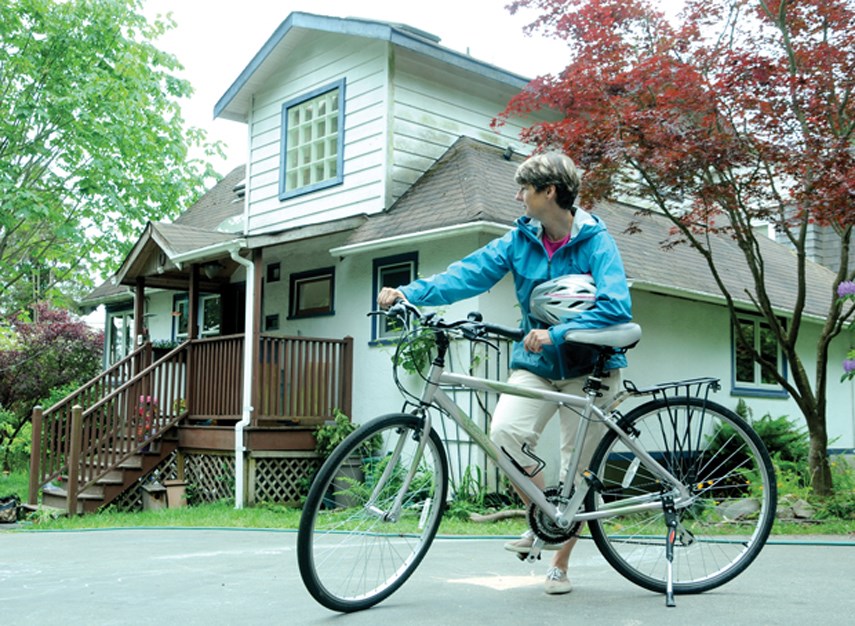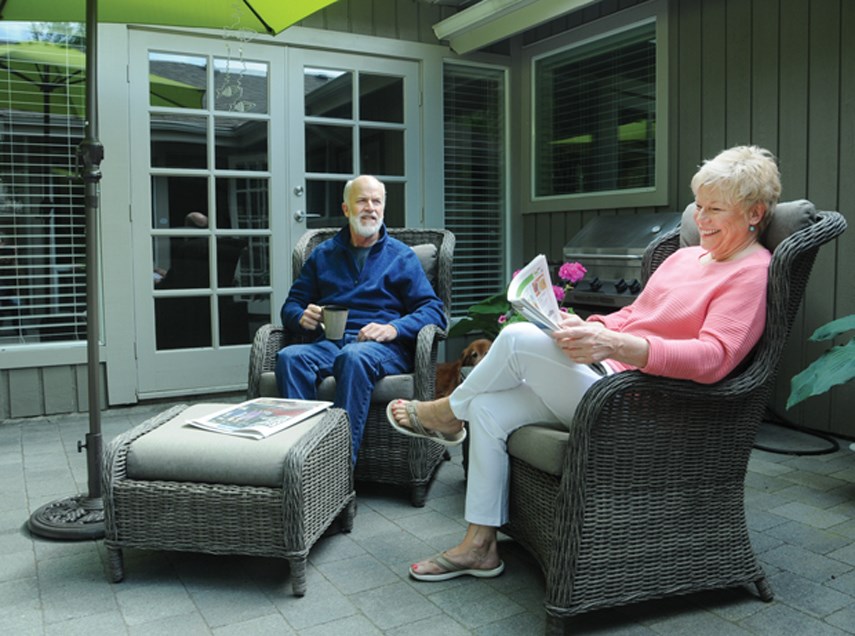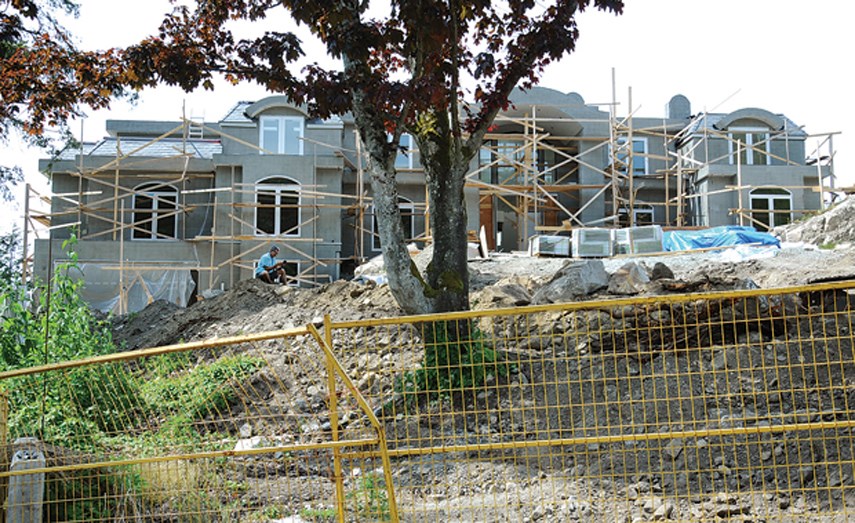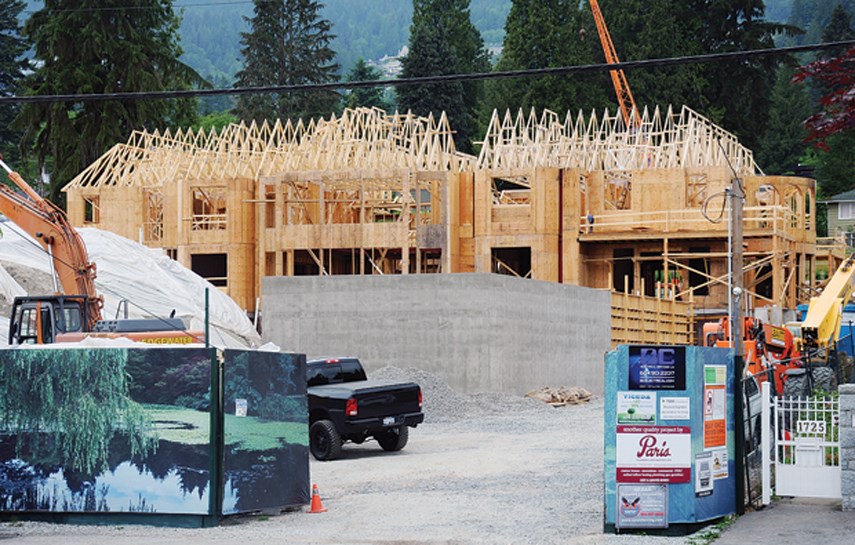This story is the third installment in a three-part series about real estate in North and West Vancouver. Click here to read part 1 and click here to read part 2.
When Anita Preiswerck was a growing up in North Vancouver, she used to hike from her Canyon Heights home, carrying skis, up to the old Grouse Mountain chair lift with her friends. There were kids in almost every house then, who would play outdoors in the forest and walk to school together.
Today, Preiswerck has come back to live in the family home her dad built more than 50 years ago at the foot of the mountain. Tall cedars and hemlocks stand sentinel in her back yard.
But the neighbourhood around her is changing fast, fueled by a real estate boom of epic proportions. “In the past year or two it’s something different,” said Preiswerck. “There seems to be no lid on it and no stopping it.”
Telltale blue and yellow construction fencing lines every other corner of the neighbourhood. Real estate signs sprout like horsetails.
A block away, two new houses are going up next door to each other. “All the way up and down Highland it’s sold, sold, sold,” said Preiswerck.
The days of a house taking months to sell are long gone too. Now it’s a week – if that. Recently, a house across the street from her sold in a matter of days for more than $2 million – $250,000 above the asking price.
“In the old days when somebody sold a house you were kind of anxious to meet your new neighbours and people were wondering if their kids were going to have friends to play with,” she said.
Now when someone buys a house, it generally sits empty for a while. “The next thing you know there are people with plans coming around. Nobody lives one day in that house to see if it’s livable or likeable,” she said.
First the oil tank is removed. Then the insulation. Then the house is torn down. “Everything just crushes and it’s just a pile of rubble and a few bricks,” she said. “You see the space it used to be in.”
The same thing recently happened on the property next door to Preiswerck. Neighbours watched as dozens of 80- and 100-foot tall cedar and hemlock trees on the lot were taken down, then the contour of the land was changed. On the other side of her neighbours’ property, a wall of dirt that has been cut away about two storeys deep is now reinforced with rebar and sprayed concrete.
Recently, a concrete compacter on the building site left everything in Preiswerck’s house – the dishes, the walls, the toilet tanks – shaking with the heavy vibration that felt like a mild earthquake.
Preiswerck worried about the impact of that on her old house and was left wondering who to call. “You’re just sort of all on your own,” she said. “Do I phone the police, do I phone North Vancouver District, do I phone the project manager? Do I have a say?
“The answer is you have no say. Everything is permitted. It’s all legal.”
Preiswerck said she let the neighbours take down a few trees on her property when they said the roots interfered with their building envelope. She discovered later that roots of her remaining trees had also been cut where they crossed the property line.
A hawthorn tree in her backyard – given to her parents by her godmother as a gift when they moved in – grows perilously close to the now radically altered building site next door.
“It’s awkward,” she said. “You don’t want to be on bad terms with them. It’s all legal but it doesn’t mean it’s right.”
The changes affecting Preiswerck’s upper Capilano neighbourhood are being felt across the North Shore as skyrocketing property values have driven a real estate gold rush. Many longtime homeowners are cashing out and getting multi-million-dollar cheques for their property. More often than not, those who buy have no intention of living in the 1950s home sitting on that $2 million, $3 million or $5 million property. Older houses are being torn down at a rapid rate and replaced with much larger new homes. In some neighbourhoods, several houses are under construction on every block.
Historically in the District of North Vancouver, there have been about 100 homes demolished and rebuilt every year, said Dan Milburn, acting general manager of planning and permits for the District of North Vancouver. In the last two years, however, that’s almost doubled. In 2015, there were 180 permits for rebuilds and “we’re anticipating a similar number for 2016,” said Milburn. About 35 per cent of those have been concentrated in upper Capilano neighbourhoods.
In West Vancouver, the trend is the same, with 174 demolitions and 171 permits for rebuilding of single-family homes issued in 2015.
Like most municipalities, both the districts of North Vancouver and West Vancouver have formulas that regulate the maximum size of a house relative to lot size. In North Vancouver, where a typical lot size is 8,200 square feet, homes can generally be constructed to a size of about 3,000 or 3,500 square feet (although there are some areas that allow larger houses – up to 5,000 and 6,000 square feet.)
In most cases, that is still significantly larger than the typical 1,200 square foot post-war bungalow that the new home replaces.
And on some larger lots in areas like West Vancouver’s Altamont neighbourhood, the size of the houses built is much bigger – more than 10,000 square feet.
It’s a trend that’s gone on for a few years now, said West Vancouver Coun. Nora Gambioli. “Everyone is building to the maximum capacity. Every square inch is used.”
Gambioli said she’s even heard stories from real estate agents about builders putting in false walls in the basement that are pulled down to reveal an additional room once the building inspection is complete.

“Everybody just wants more and more space,” she said.
Part of what’s driving the building boom in huge houses is economic. Those buying multi-million-dollar real estate want to maximize their property value for resale, which won’t happen if they leave that 1950s rancher standing. Buyers of those properties expect new multi-million-dollar houses to go with them.
Offshore buyers – who make up a large part of the high-end real estate market on the North Shore – prefer large, new homes with expansive views.
The way the housing market has quickly reached a fever pitch has left local governments gasping to catch up.
“We hear concerns on the street every day,” said Gambioli. “But government is always way behind the eight ball. The market is just out of control. We are just kind of running behind.”
Local government has largely been “puttering along” with the same rules about house size that it’s had for 40 years, said Gambioli.
“No one’s ever pushed it to the limit it’s been pushed to now.”
The most striking example of the trend happened earlier this year when Vancouver businessman Ge Chen consolidated two lots directly across from the high school on Mathers Avenue and subsequently had building permits approved for a 24,500 square foot home (including the garage and basement.)
Neighbours quickly took notice. “I call it the White House North,” said Alex Rose, who lives a couple of blocks away on St. Denis Road. “When people go by their jaws drop.”
Rose said, “some people get irritated” by the house, but adds he doesn’t blame Chen. “He played by the rules. Whether it offends someone else’s sensibility it’s an entirely different thing.”
Rose said he holds the municipality responsible, for not having tighter regulations. “It’s just like the Wild West.”
But debates about restricting house size have proved divisive in West Vancouver. Council is expected to give final reading soon to a bylaw limiting maximum house size on consolidated lots. Under that bylaw, Chen’s massive house wouldn’t be permitted.
Last year, however, the majority of council voted down a bylaw which would have put the brakes on the massive Mathers house, following a raucous public meeting where builders, developers and others spoke out loudly against limits on the size of homes.
“It was a very intimidating meeting,” said Gambioli.
“I would love to see a cap (on maximum house size),” she added.
Gambioli and her own family recently moved into a home of about 2,500 square feet, built in 1938, that she’s planning to fix up.
“Anything above 3,000 square feet in my personal opinion for a family is unsustainable.”
Jim Bailey, the director of planning for West Vancouver, understands the desire by some people to limit large houses. “In a lot of ways it makes sense you would do that. It’s also very polarizing,” he said.
At public meetings, developers weren’t the only ones concerned. “A lot of people said my house is my investment. If you reduce my house size you reduce my equity,” he said.
The West Vancouver of yesterday is changing, said Bailey, and that can’t but help impact the community.
“You go from a sense of West Vancouver being a pretty small little village far away from Vancouver nestled in the woods with your 1950s bungalow next to your creek. Then you have a 25,000 square foot house. That elicits a different response and feeling from people.”
Roberta and Malcolm McLaren are familiar with that.
In 2001, they moved back to the West Bay neighbourhood in West Vancouver Malcolm had grown up in, after buying the family home there from his mother.
Built and designed by his uncles, the house had been home to Malcolm, his parents and two brothers during the 1950s and 1960s.
“It was well built,” he said – not surprising considering the McLaren family’s shipbuilding pedigree. “We still knew people in the area. It was a sunny lot.”
The couple renovated inside the home, but kept all of the external walls. “I always like to say we kept its integrity,” said Roberta.

The first two years in the neighbourhood were good, said the couple. Then the trouble started. A house nearby was bulldozed, then “they dynamited for months,” said Roberta.
“Then the next house came down. Same thing. The next, the next, the next. It just kept going after that one.”
Trucks idled in the morning and the road was filled with dirt from the construction sites. The last straw was when new owners tore down the house next door and started on a two-and-half-year construction project.
“They covered the house with granite and each piece of granite they sawed outside our window,” said Roberta.
When the house was finished. “It looked like a fortress,” she said, with fluorescent lighting flooding their home and backyard at night.
It got to the point where “my heart sank, living next to this place,” she said. “I said ‘I can’t be here anymore. It just makes me sad.’”
Almost all the old houses on that block are now gone, replaced with massive new homes and gated driveways.
The couple sold, and moved to an older home in a leafy neighbourhood of Lynn Valley, close to their daughter. “I wouldn’t move to anywhere in West Vancouver again because every neighbourhood is just the same,” said Roberta.
The McLarens aren’t alone.
In one Caulfeild neighbourhood, acrimony between one set of owners – who are building a 12,000 square foot home – and their next-door neighbours has ended up in legal suits.
David and Amber Trent are no longer talking about their situation, on the advice of their lawyer.
But court documents filed in B.C. Supreme Court indicate the Trents were shocked to find the property next door “stripped to the bare rock” while they were out of the country in the summer of 2014.
When they got back, the Trents said in court documents, they soon had other concerns, about the safety of large equipment working very close to their property line, lack of adequate safety fencing and rocks that were falling down in their yard, close to their young children’s toys. On some occasions the family “vacated their home entirely,” according to court documents, “because they felt it was unsafe to be in the house.”
Eventually the Trents filed a lawsuit for damages. Their neighbours – Catherine Zhao and Dong Biao Huang of West Vancouver – fired back with a counterclaim, denying those allegations and suing the Trents for defamation, alleging the Trents had strategically placed rocks on their own property for the benefit of the media and caused unnecessary delays to their project.
In court documents, Zhao and Huang denied they are building a “monster house” and wrote they had been subject to media commentary “with derogatory remarks implying that being Chinese, (they) have little grasp of Vancouver sensibilities and by building a bloated house will not be welcomed by the community.”
Attempts to reach Zhao and Huang through their lawyer’s office were unsuccessful. The case is still currently before the courts.
Two years after it started, the house on Kensington Crescent is still under construction.
Beth Boxall, who lives a street away, has watched that from a distance, along with construction of several other large homes in the neighbourhood.

She said her modest 1950s Lewis post-and-beam home has been subject to a barrage of shaking over recent years, as each project blasts rock to make way for a large basement.
“We had a big sliding glass door in our basement blow out in the middle of the night,” she said, adding the edge of her deck has dropped and there are new cracks in her walls.
In one case, “the blasting company told me if I didn’t like it go hire a lawyer,” she said. “Basically the guy told me to go pound dirt.”
When she did call a lawyer he told her, “‘This stuff goes on all the time. People like you can’t afford a lawyer like me.’”
Another home has recently been sold on her street and she’s not optimistic about what’s going to happen. “They’re going to go in there and take all the trees out,” she said. “There will be building permits and more blasting.”
“As Canadians we do have a sense of trying to work things out and be neighbourly,” she said.
Faced with constant construction of massive homes, that can be difficult. It’s a scene that is being repeated all over the North Shore.
But District of North Vancouver Mayor Richard Walton said the large homes being built now are no more out of place than the original houses were when they went in 50 years ago.
Back then, “They came in and they took out every single tree. Most of the creeks were bulldozed over. They absolutely savaged the lands” to create a subdivision, he said.
“There were no environmental controls. It was ugly. Twenty years ago Edgemont Village was a wasteland.”
The size of the houses being built and the disruption to the landscape aren’t the only issues up for debate. Building aesthetics are another controversial topic.
Sometimes it’s the style as much as the size of the house next door that people object to. “I call them bunkers,” said Gambioli of many new houses. “The design is very different from what we’re used to.”
Gambioli said she’d love to have greater regulation of house designs.
Others don’t share Gambioli’s enthusiasm for telling people what they should build on their property.
“We live in a world where people do not want government in their face,” said Walton. “They say, ‘It’s my lot, it’s my land, it’s my tree. Get out of my face.’ We don’t have bylaws that have what colour you paint your house. Where does it end?”
For a group of West Vancouver architects who have been discussing the issue, however, it’s one that warrants consideration.
“It’s not really a square footage issue,” said Katie Hlynsky, who talked about the issue with her father Gordon Hlynsky and Cedric Burgers, all architects practicing in West Vancouver.
In other jurisdictions, like some communities in California, there are much bigger incentives to build homes in keeping with the neighbourhood, she said. “Here there’s no incentive for good design.”
In fact, for single-family homes, “You can have anybody come in off the street and design it” – as long as it meets the building code and municipal rules, said Burgers. “It’s a completely unregulated thing.”
But the size of new houses being built – which in some cases rivals that of a medical clinic or a small rec centre – complicates that free-for-all approach.
“To me there’s a tipping point between a large and small house,” said Burgers. “It’s somewhere around 6,000 feet that’s large.
“I really think what when houses get up to that scale they become commercial projects. They’re not homes anymore. I’m not saying no to them but they need to have some oversight.”
All three support dialing down the existing house-to-lot ratio to keep most homes smaller. Larger homes would still be allowed, they said – but would be subject to some kind of design panel review first, which would look at issues like the impact on the neighbours.
That could be more complicated than it seems at first glance. The province determines what kind of bylaws municipalities can put in place and those regulations can be very restrictive.
But the architects argue it’s worth finding solutions in the long run.
In the past, West Vancouver architecture made famous by people like Arthur Erickson, Fred Hollingsworth and Ron Thom was all about blending in to the landscape, rather than blasting it to bits.
Katie Hlynsky grew up in the 3,500 square feet of the 1950s Altamont home that her father carefully renovated, set back into a lush garden with a creek nearby. “I thought I grew up in a palace,” she said.
“When you look at these houses that are knocked down, probably half of them could have been saved rather than nuking the whole site,” said Gordon Hlynsky. “It used to be house and garden. Now it’s house and house.”
He’s had the issue brought close to home recently, as new owners prepare to build a massive 12,000 square foot home next door to him, with plans for a wall of windows overlooking his back yard.
He admits he’s worried about what the future holds – both for his own home and for those who live on the North Shore.
“A monster is not a big house,” said Katie Hlynsky. “A monster is something that overtakes something else.”



